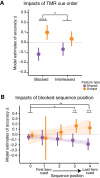Memory Reactivation during Sleep Does Not Act Holistically on Object Memory
- PMID: 38604779
- PMCID: PMC11170671
- DOI: 10.1523/JNEUROSCI.0022-24.2024
Memory Reactivation during Sleep Does Not Act Holistically on Object Memory
Abstract
Memory reactivation during sleep is thought to facilitate memory consolidation. Most sleep reactivation research has examined how reactivation of specific facts, objects, and associations benefits their overall retention. However, our memories are not unitary, and not all features of a memory persist in tandem over time. Instead, our memories are transformed, with some features strengthened and others weakened. Does sleep reactivation drive memory transformation? We leveraged the Targeted Memory Reactivation technique in an object category learning paradigm to examine this question. Participants (20 female, 14 male) learned three categories of novel objects, where each object had unique, distinguishing features as well as features shared with other members of its category. We used a real-time EEG protocol to cue the reactivation of these objects during sleep at moments optimized to generate reactivation events. We found that reactivation improved memory for distinguishing features while worsening memory for shared features, suggesting a differentiation process. The results indicate that sleep reactivation does not act holistically on object memories, instead supporting a transformation where some features are enhanced over others.
Keywords: NREM sleep; category learning; consolidation; replay; targeted memory reactivation.
Copyright © 2024 the authors.
Conflict of interest statement
The authors declare no competing financial interests.
Figures






Update of
-
Memory reactivation during sleep does not act holistically on object memory.bioRxiv [Preprint]. 2024 Mar 15:2023.12.14.571683. doi: 10.1101/2023.12.14.571683. bioRxiv. 2024. Update in: J Neurosci. 2024 Jun 12;44(24):e0022242024. doi: 10.1523/JNEUROSCI.0022-24.2024. PMID: 38168451 Free PMC article. Updated. Preprint.
References
-
- Andermane N, Zhai C, Henderson L, Horner AJ (2023) The holistic forgetting of events and the (sometimes) fragmented forgetting of objects. Available at: https://osf.io/tb67g [Accessed December 11, 2023].
MeSH terms
Grants and funding
LinkOut - more resources
Full Text Sources
